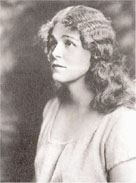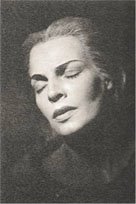Callas-lite
But of course we were at this season's opening night at the Met. Sieglinde has been a stalwart of our diva Sondra Radvanovsky since we've heard her as Serving Woman in Elektra in the late 1990s, back in the day when Gabriele Schnaut, in the title role, molested our eardrums with daggers while Deborah Voigt, a hefty Chrysothemis, soothed the pain with cream. (Oh those were the days of yore ...) OK, we jest: you don't care about Serving Women, and neither do we. Anyway, Sondra quietly rose through other minor roles, through Musetta, and then to Luisa Miller, her first serious top bill which we scarcely remember because the opera itself is (don't hate us!) a snoozefest.
Her Leonora in Il Trovatore in 2000 (more than two decades ago!) marked a turn towards stardom. Those performances predate these Diaries so we can't provide blow-by-blow details, but what we remember was a house-filling lachrymose voice, veiled grey if a bit monochromatic, but oozing with mournful distress that was resolutely devastating in those "Ah! Le pene" wails in Act IV. We marvelled at how a thick sound could scale those high notes with bel canto precision; and oh, we were thrilled to have heard, dare we even say, the sonic shadow of La Divina herself.
Next was I Vespri Siciliani in 2004, right around when these Diaries were born. We blogged those performances heavily. After one particular performance in November, 2004, we thus declared:
Sondra then went through a spate of Verdi's in the late aughts, which these Diaries somehow skipped. Only when her Tosca's were presented did the Diaries take note, as in this post from January, 2011:
Which brings us to this season's Medea. Even if you're not paying attention till now, you can't deny that this stunt automatically invites direct comparison to Callas (the true reason Medea hasn't been performed at the Met till this year). Regardless, our girl can do the role with the kind of pathos and fury that stirs opera queens out of their seats and throw confetti. Maestro Carlo Rizzi knows how to drive an Italian work on overdrive, and he surely maneuvered a vibrant evening of intense melodramatic singing from all the principals, including tenor Matthew Polenzani, a fellow American old-timer at the Met.
Sieglinde was deeply moved, for sure. Yet one question interrupts this predictable storyline--why did we only see the prima? Why didn't we go back for more? What was missing? Was there too much of Callas in this whole endeavor and in the face of Sondra's voice that she must inevitably be discarded as plastic imitation? Where was the delirium? Is Sieglinde's stupor just a sign of old age? Sondra is scheduled to bulldoze New York with Turandot next season. Let's see how those performances lay waste to these trivial, pointless musings.
Her Leonora in Il Trovatore in 2000 (more than two decades ago!) marked a turn towards stardom. Those performances predate these Diaries so we can't provide blow-by-blow details, but what we remember was a house-filling lachrymose voice, veiled grey if a bit monochromatic, but oozing with mournful distress that was resolutely devastating in those "Ah! Le pene" wails in Act IV. We marvelled at how a thick sound could scale those high notes with bel canto precision; and oh, we were thrilled to have heard, dare we even say, the sonic shadow of La Divina herself.
Next was I Vespri Siciliani in 2004, right around when these Diaries were born. We blogged those performances heavily. After one particular performance in November, 2004, we thus declared:
What came next were the Don Carlo's in 2005. We cannot tell you why these Diaries were mostly silent about those performances. We surely attended at least a couple of evenings, but are surprised to retrieve only naked passing references to what appeared to be tumultuous evenings. WTF, right? (We do remember that around the same time, Maria Guleghina (oceanliner, skyscraper, continent) was defying physics as Abigaille, so that could have possibly diverted our attention.)One isn't being unreasonable to suggest (gasp) Callas in describing the over-all affect of Sondra Radvanovsky's voice; indeed, both voices bear the dark veil of quiet suffering whatever the aria or context. Radvanovsky's instrument has grown a shade darker since her Trovatore Leonoras a couple of years ago, and has become significantly more flexible, but has thankfully lost none of its staggering volume. Last night she used the default emotion intrinsic to her instrument to produce a most heartrending "Arrigo! ah parli ad un core," and with such talent she is assured to be remembered by this generation of fans.
...
Anyway, she's a young soprano with a young career, and the vocal development I have noticed the past couple of years signifies to me that she's headed in the right direction. To be compared to our favorite divas at this point in her life is true testament to her enormous talent and potential. Already she has defied the American curse by nurturing a distinct voice with personality and edge; now in order to succeed in this kind of repertory, she has only to delve deeper into the Latin aspect of her soul: i.e., show emotion beyond the dark veil, and please apply the chest!
Sondra then went through a spate of Verdi's in the late aughts, which these Diaries somehow skipped. Only when her Tosca's were presented did the Diaries take note, as in this post from January, 2011:
The mid-2010's was a difficult period for Sieglinde so much so that (gasp!) she missed Sondra's historic Three Donizetti Queens entirely. (Sieglinde also stopped blogging around that time.) If we could get a hold of a time machine, this may be one temporal destination. Sieglinde shall speak about these dark years when the time is right. However, neither rain, nor snow, nor sleet, nor hail shall keep her from seeing any Norma, especially one which promises to rearrange the Pantheon. If these Diaries were still active around that time, it would have exploded in excessive worship. Sondra reached a pinnacle, her voice a physical force, a sure contrast to a series of flawed Norma's, beginning in 2001 (Jane Eaglen, Hasmik Papian, Maria Guleghina) after being absent from the repertory for a generation. And we must mention that Joyce DiDonato, as Adalgisa, exceeded all expectations and demonstrated supreme virtuosity despite an unmemorable sound.The throbbing, relentlessly lachrymose and sonically gifted soprano of Sondra Radvanovsky enters a new dimension. She probably vaporized many in-house recordings and shattered hidden microphones tonight, with the sheer gigabigness of her top notes and that characteristic, mechanical vibrato. But the good news is that she's finally using some chest tones! Not a lot, not as big, and not consistently, but they were there when it mattered ...
Which brings us to this season's Medea. Even if you're not paying attention till now, you can't deny that this stunt automatically invites direct comparison to Callas (the true reason Medea hasn't been performed at the Met till this year). Regardless, our girl can do the role with the kind of pathos and fury that stirs opera queens out of their seats and throw confetti. Maestro Carlo Rizzi knows how to drive an Italian work on overdrive, and he surely maneuvered a vibrant evening of intense melodramatic singing from all the principals, including tenor Matthew Polenzani, a fellow American old-timer at the Met.
Sieglinde was deeply moved, for sure. Yet one question interrupts this predictable storyline--why did we only see the prima? Why didn't we go back for more? What was missing? Was there too much of Callas in this whole endeavor and in the face of Sondra's voice that she must inevitably be discarded as plastic imitation? Where was the delirium? Is Sieglinde's stupor just a sign of old age? Sondra is scheduled to bulldoze New York with Turandot next season. Let's see how those performances lay waste to these trivial, pointless musings.





